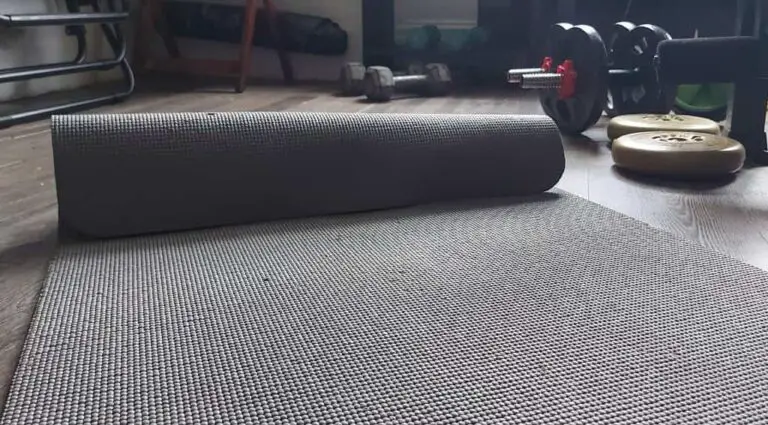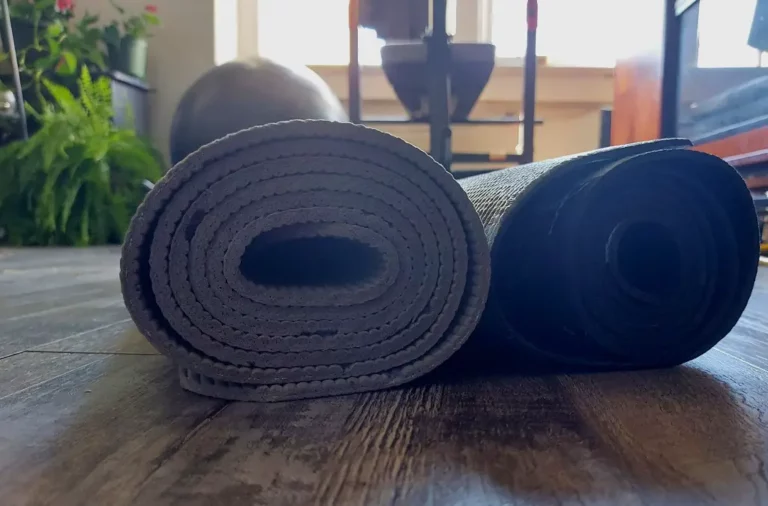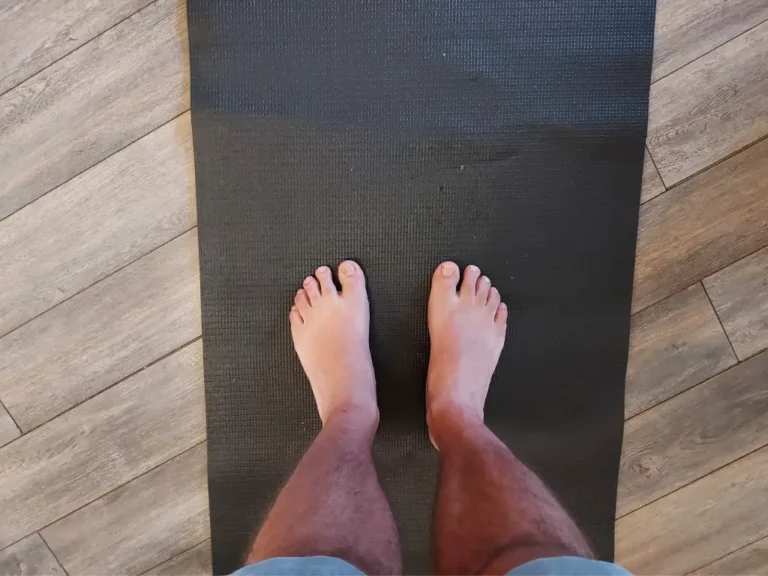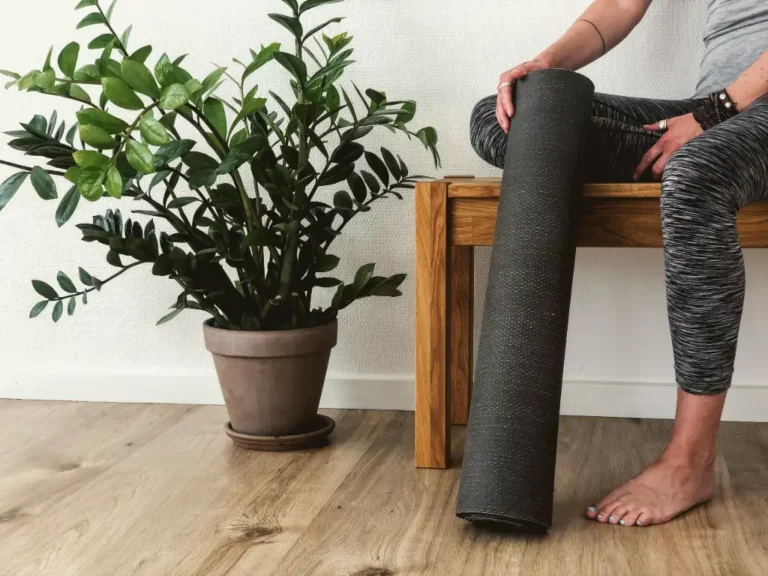How Much Weight of a Yoga Mat Is Too Much for Travel?

Are you a yoga enthusiast who loves to travel yet still wants to maintain your practice? Finding the perfect travel yoga mat is like finding a rare gem. You might be wondering the ideal weight for a travel yoga mat. The answer depends on your personal preferences and packing skills. Luckily, travel yoga mats are designed to be lightweight and portable, making them a fantastic companion for on-the-go yogis.
To ensure easy transportation without adding excess weight to your luggage or backpack, it is recommended to choose a mat that weighs less than 2 pounds (0.9 kg).
In this piece, we will explore the different factors to consider when selecting a travel yoga mat and some useful tips to simplify decision-making.
Recommended Weight for Travel Yoga Mats
If you’re searching for a travel yoga mat, aim for one that weighs less than 2 pounds (0.9 kg) for easy portability. The recommended weight for travel yoga mats is less than 2 pounds, as they’re designed to be light and portable. This ensures you can effortlessly carry the mat wherever you go without adding excessive weight to your luggage or backpack.
There are various travel yoga mats available that meet this recommended weight. For example, the Jade Voyager Mat weighs only 1.5 pounds, making it an excellent choice for those who prioritize lightweight travel gear. Another option is the Yogo Ultralight Folding Mat, which weighs just 2.1 pounds. These thin mats still provide adequate support and comfort during your yoga practice.
The Gaiam Foldable Mat, weighing 2 pounds, is an excellent option if you prefer a slightly heavier mat that balances weight and cushioning. It provides more padding than the thinner mats while still being lightweight for travel.
Lastly, the Manduka eKO SuperLite is another suitable choice, weighing 2.2 pounds. It offers a lightweight design perfect for travel without compromising quality or durability.
Benefits of Lightweight Travel Yoga Mats
- Lightweight travel yoga mats offer convenient portability for active individuals on the go. These mats are designed to be light and easy to carry, making them the perfect choice for frequent travelers or those who enjoy staying active while exploring new places. Their compact size and folding capabilities allow you to effortlessly pack them into your luggage or backpack without taking up much space. With a lightweight and portable mat, you can create a dedicated space for your yoga practice wherever you are, whether in your hotel room, at the beach, or in a park.
- One of the key advantages of lightweight travel yoga mats is that they protect your primary yoga mat from wear and tear, extending its lifespan. Using a travel mat, you can keep your favorite mat in excellent condition and ensure it lasts longer.
- Additionally, these mats aren’t limited to yoga practice alone. They’re versatile enough for stretching, Pilates, HIIT, and other exercises. So, if you enjoy diversifying your workouts or trying different forms of exercise, a lightweight travel yoga mat can be a great investment.
Factors to Consider When Choosing a Travel Yoga Mat
When choosing a yoga mat for your travels, it’s crucial to consider several factors that will assist you in making an informed decision.
- YOGA MAT FOR TRAVEL: This 2mm thick non toxic PVC yoga mat easily folds into a 10 inches x 12 inches…
- FITS IN CARRY-ON BAG: This foldable yoga mat easily fits in your carry-on or overnight bag – also a…
One of the primary considerations is the weight of the mat. Since you’ll carry it, opt for a lightweight mat that won’t burden your luggage. Aim for a mat that weighs less than 2 pounds (0.9 kg) to ensure convenient portability.
Another significant aspect to consider is the grip of the mat. Choosing a mat that offers excellent traction to prevent slipping and maintain stability during your yoga sessions is essential. While foam mats are lightweight, they mightn’t provide optimal grip. On the other hand, rubber mats offer superior traction but may be heavier.
Durability is also a key factor to take into account. You want a mat that’s built to last and can withstand the demands of travel. Look for mats crafted from high-quality materials designed to endure wear and tear.
Lastly, consider the ease of cleaning the mat. You’ll want a mat that’s easy to clean and maintain when you’re on the go. Look for mats that can be effortlessly wiped down with a vinegar and water solution.
Top Considerations for Packing a Yoga Mat for Travel
When traveling with your yoga mat, it’s essential to consider a few key factors for a seamless and stress-free experience. Here are some important things to keep in mind:
- Weight: Prioritize a lightweight travel yoga mat that weighs less than 2 pounds (0.9 kg) for effortless portability. This will ensure that your luggage remains manageable during your journey.
- Thickness: Opt for a thin and lightweight mat with a thickness of around 1.5 mm. This will provide adequate support and cushioning for your yoga practice without adding unnecessary weight to your travel gear.
- Portability: Look for a mat that can be easily folded or rolled into a compact size. This will make fitting into your travel luggage conveniently without occupying too much space.
- Grip: Make sure the mat offers a grippy surface to keep your hands and feet secure during practice. This becomes particularly crucial when practicing outdoors, where the ground may be uneven.
- Durability: Consider the material and construction of the mat to ensure it can withstand the rigors of travel and outdoor use. Natural rubber mats often strike a balance between lightweight design and durability. Also, choose a mat that’s easy to clean, simplifying maintenance and hygiene during your travels.
Tips for Keeping a Travel Yoga Mat Clean and Dry
To ensure the longevity and cleanliness of your travel yoga mat, it’s important to maintain it properly during your journeys. Keeping your travel yoga mat clean and dry is essential for its durability and hygiene. Here are some helpful tips to assist you in this process.
To begin with, regular cleaning of your travel yoga mat is crucial. Use warm water and mild detergent to gently scrub the mat, removing any dirt, sweat, or oils that may have accumulated during your practice. Avoid harsh chemicals or abrasive materials that could harm the mat’s surface.
After cleaning, it’s essential to dry your travel yoga mat thoroughly. The best approach is to dry it in a cool, shaded area away from direct sunlight. Excessive heat can cause the mat to warp or lose its grip. You can hang it or lay it flat to allow proper airflow and prevent mold or mildew growth.
If you need to clean your mat while on the go, consider carrying a small spray bottle filled with white vinegar and water. Vinegar is a natural disinfectant and can effectively eliminate bacteria from your mat. Spray the solution onto the mat, wipe it down, and allow it to air dry.
Frequently Asked Questions
Can I Travel With a Yoga Mat?
Yes, you can travel with a yoga mat. Take into consideration your personal preferences and packing capabilities. Look for a lightweight mat weighing less than 2 pounds for easy transportation without adding excessive weight to your luggage or backpack.
How Much Does a Travel Yoga Mat Weigh?
A travel yoga mat typically weighs less than 2 pounds for easy travel. Thinner mats reduce weight while still providing support. Consider personal preferences and packing capabilities when deciding how much weight is excessive.
What Is a Good Weight for a Yoga Mat?
Finding the right weight for your yoga mat depends on your preferences and packing capabilities. Opting for a mat that weighs less than 2 pounds is generally recommended for convenient travel. Thinner mats can help reduce weight without compromising support and comfort.
Are Travel Yoga Mats Worth It?
Yes, travel yoga mats are worth investing in. These mats are specifically designed to be lightweight and portable, making them incredibly convenient for yogis who are always on the move. They offer unique features such as a sticky surface and added padding to protect your knees, making them perfect for practicing yoga while traveling.
Travel yoga mats provide many benefits, making them valuable companions. Firstly, their lightweight nature allows you to easily carry them in your backpack or suitcase without adding unnecessary weight. Secondly, their portability means you can practice yoga wherever you go, whether in your hotel room, a park, or even at the beach.
Additionally, these mats are equipped with a sticky surface that provides excellent grip, ensuring that you can hold your poses with stability and confidence. This is especially important when practicing on different surfaces that may be slippery or uneven. Moreover, the added padding on travel yoga mats offers essential cushioning for your knees, providing comfort and support during your practice.
Travel yoga mats are practical and functional and come in various designs and colors, allowing you to express your style and enhance your yoga experience. With their compact size and convenient carrying straps, you can easily take them anywhere without hassle.
Conclusion
When choosing a travel yoga mat, it’s crucial to consider weight as a key factor. Opting for a mat that weighs less than 2 pounds (0.9 kg) ensures easy transportation without adding unnecessary weight to your luggage.
Additionally, thinner mats can further reduce weight while providing the necessary support and comfort during yoga.
By selecting a lightweight and portable mat, you can enjoy your yoga practice while on the go without any added burden.







